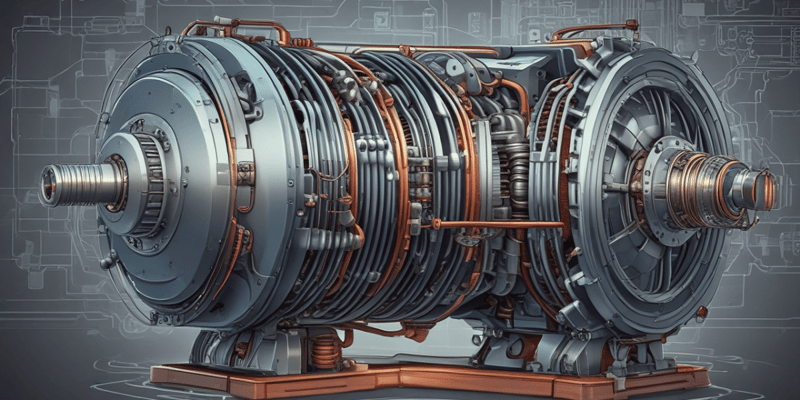10 Questions
What are the two primary categories of synchronous motors based on the type of rotator's magnetic source?
Permanent magnet (PM) synchronous motors and synchronous motors with an externally excited rotator
Explain one advantage of synchronous motors over induction motors.
Synchronous motors operate with a locked rotator-stator relationship, offering specific advantages in applications requiring precise speed control.
Provide an example application where synchronous motors are commonly used.
Synchronous motors are commonly used in applications like precision instrumentation, robotics, and high-performance machines.
What is a significant disadvantage of synchronous motors compared to induction motors?
Synchronous motors require complex control systems to maintain synchronization with the power supply frequency.
Explain the working principle of synchronous motors in terms of the relationship between the rotator and stator.
Synchronous motors operate with a 90-degree phase difference between the rotator and stator, ensuring the magnetic flux is always perpendicular to the rotator's rotation plane.
Explain the working principle of a synchronous motor.
The interaction between the stator's rotating magnetic field and the rotator's magnetic field results in the rotation of the rotator.
What are the advantages of synchronous motors?
- High efficiency 2. Constant speed 3. Torque control 4. Long service life
Give an example of a high-performance application where synchronous motors are commonly used.
Machine tools, pumps, and fans
What are the disadvantages of synchronous motors?
- Cost 2. Higher design complexity 3. Requirement for external power supply 4. Limited speed range
In what type of renewable energy applications are synchronous motors used?
Wind turbine generators and electric vehicle applications
Study Notes
Synchronous Motors
Synchronous motors are electrical devices that convert electrical energy into mechanical rotational force, sharing similarities to asynchronous (induction) motors but with some distinct features. Unlike induction motors, which rely on the interaction of rotating magnetic fields, synchronous motors operate with a locked rotator-stator relationship, offering unique advantages and applications.
Types
Synchronous motors can be divided into two primary categories:
- Permanent magnet (PM) synchronous motors: These motors use strong, permanent magnets as the rotator's magnetic source.
- Synchronous motors with an externally excited rotator: This type of motor uses a rotator wound with an electric current-carrying coil, located within the rotator's magnetic field to create the magnetic flux.
Working Principle
Synchronous motors operate based on the principle of synchronization. The rotator rotates at a constant speed, which is equal to the rotating magnetic field's speed. The rotator and stator generate a phase difference of 90 degrees at any given time, ensuring that the magnetic flux is always perpendicular to the rotator's rotational plane.
The stator of the synchronous motor is composed of alternating current (AC) windings arranged in slots around a cylindrical core. When the stator is connected to an AC power supply, it generates a rotating magnetic field. The rotator can be a permanent magnet or a wound rotator excited by an external DC power supply. The interaction between the stator's rotating magnetic field and the rotator's magnetic field results in the rotation of the rotator.
Advantages
- High efficiency: Synchronous motors are known for their high efficiency, making them ideal for applications requiring high efficiency and low power loss.
- Constant speed: The synchronous motor's rotator rotates at a constant speed, which is directly proportional to the frequency of the power source. This allows for precise speed control and accurate positioning.
- Torque control: The synchronous motor's torque can be controlled by varying the excitation current provided to the rotator.
- Long service life: The absence of sliding contacts in the PM synchronous motor design results in fewer wear problems and longer service life.
Applications
- High-performance applications: Synchronous motors are commonly used in high-performance applications, such as machine tools, pumps, and fans, where precise speed control and high torque are required.
- Servo systems: Synchronous motors are often used in servo systems, which require fast response times and high accuracy.
- Renewable energy: Synchronous motors are also used in wind turbine generators and electric vehicle applications.
Disadvantages
- Cost: Synchronous motors are more expensive than their asynchronous counterparts due to their more complex design and the need for external excitation (in the case of externally excited synchronous motors).
- Higher design complexity: Synchronous motors require careful design and manufacturing to achieve optimal performance.
- Requirement for external power supply: Externally excited synchronous motors require an external DC power supply, which adds to the system's complexity.
- Limited speed range: Synchronous motors have a limited speed range due to their constant speed operation. Slip rings can be used to increase the speed range, but this adds additional complexity and cost.
While synchronous motors offer advantages in specific applications, their higher cost and design complexity make them less suitable for general-purpose use. However, advances in technology continue to make them more accessible as they offer enhanced performance and efficiency over asynchronous motors.
Explore the types, working principle, advantages, and applications of synchronous motors in this quiz. Learn about permanent magnet synchronous motors, synchronization principles, torque control, and high-performance applications.
Make Your Own Quizzes and Flashcards
Convert your notes into interactive study material.
Get started for free




